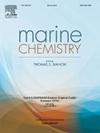南极夏季德雷克海峡和南极半岛北部海相碳酸盐体系的空间变异
IF 2.5
3区 地球科学
Q2 CHEMISTRY, MULTIDISCIPLINARY
引用次数: 0
摘要
物理和生物地球化学过程对南大洋碳酸盐体系变异性的影响仍然知之甚少。了解这种影响对于区分自然变化和人为影响以及准确解释观测到的趋势至关重要。本文研究了物理和生物地球化学过程如何影响德雷克海峡和南极半岛北部夏季碳酸盐系统变量的空间分布。在2019年南夏期间,收集了连续高频表面CO2分压(pCO2)、溶解氧(O2)和基本水文变量,而在总碱度重建和评估后,估算了其他碳酸盐系统变量。我们的研究结果表明,在德雷克海峡,环极深水上升流增加了二氧化碳分压(>;400 μatm)和溶解的无机碳(>;2175 μmol kg−1),导致pH降低(<;7.99)极地锋以南。在极锋以北,光合作用降低二氧化碳分压(<;390 μatm),同时增加pH (>;8.00)和碳酸盐离子(>;110 μmol kg−1),富集发生在亚南极球石藻生长期。在南极半岛北部,包括Gerlache海峡、南极海峡和Admiralty湾,光合作用和海冰/冰川融化是二氧化碳分压降低到350 μatm以下的主要驱动因素。环极深水与威德尔海密集陆架水的混合可以自然和人为地提高南极半岛北部水域的二氧化碳分压,降低pH值,与邻近地区相比,那里的pH值通常较低(低至7.90)。尽管如此,大多数环境在碳酸盐矿物方解石和文石方面仍然过饱和,尽管文石欠饱和的迹象在受稠密陆架水影响的地表水中已经出现。这些发现为研究南大洋广大地区的碳酸盐体系过程提供了新的见解,提高了对海洋碳动力学空间变异性的理解。本文章由计算机程序翻译,如有差异,请以英文原文为准。
Spatial variability of marine carbonate system along the Drake Passage and northern Antarctic Peninsula during the austral summer
The influence of physical and biogeochemical processes on the variability of the carbonate system in the Southern Ocean remains poorly constrained. Understanding this influence is crucial to distinguish natural variations from anthropogenic impacts and accurately interpret observed trends. Here, we investigate how physical and biogeochemical processes influence the spatial distribution of summer carbonate system variables along the Drake Passage and northern Antarctic Peninsula. Continuous, high-frequency surface partial pressure of CO2 (pCO2), dissolved oxygen (O2) and essential hydrographic variables were collected during the austral summer of 2019, whereas other carbonate system variables were estimated after the reconstruction and evaluation of total alkalinity. Our findings show that in the Drake Passage, Circumpolar Deep Water upwelling increases the pCO2 (> 400 μatm) and dissolved inorganic carbon (> 2175 μmol kg−1), leading to reduced pH (< 7.99) south of the Polar Front. North of the Polar Front, photosynthesis lowers pCO2 (< 390 μatm), while increasing pH (> 8.00) and carbonate ions (> 110 μmol kg−1), with enrichment occurring in the Subantarctic coccolithophore growth region. Along the northern Antarctic Peninsula, including Gerlache Strait, Antarctic Sound, and Admiralty Bay, photosynthesis and sea ice/glacial melt are the main drivers of pCO2 reductions to levels below 350 μatm. The mixing of Circumpolar Deep Water with Weddell Sea Dense Shelf Water can naturally and anthropogenically raise pCO2 and decrease pH in northern Antarctic Peninsula waters, where pH is generally lower (as low as 7.90) compared to adjacent areas. Nevertheless, most environments remain supersaturated with respect to carbonate minerals calcite and aragonite, although signs of aragonite undersaturation have occur in surface waters influenced by Dense Shelf Water. These findings offer new insights into carbonate system processes across a large Southern Ocean region, improving understanding of spatial variability in marine carbon dynamics.
求助全文
通过发布文献求助,成功后即可免费获取论文全文。
去求助
来源期刊

Marine Chemistry
化学-海洋学
CiteScore
6.00
自引率
3.30%
发文量
70
审稿时长
4.5 months
期刊介绍:
Marine Chemistry is an international medium for the publication of original studies and occasional reviews in the field of chemistry in the marine environment, with emphasis on the dynamic approach. The journal endeavours to cover all aspects, from chemical processes to theoretical and experimental work, and, by providing a central channel of communication, to speed the flow of information in this relatively new and rapidly expanding discipline.
 求助内容:
求助内容: 应助结果提醒方式:
应助结果提醒方式:


